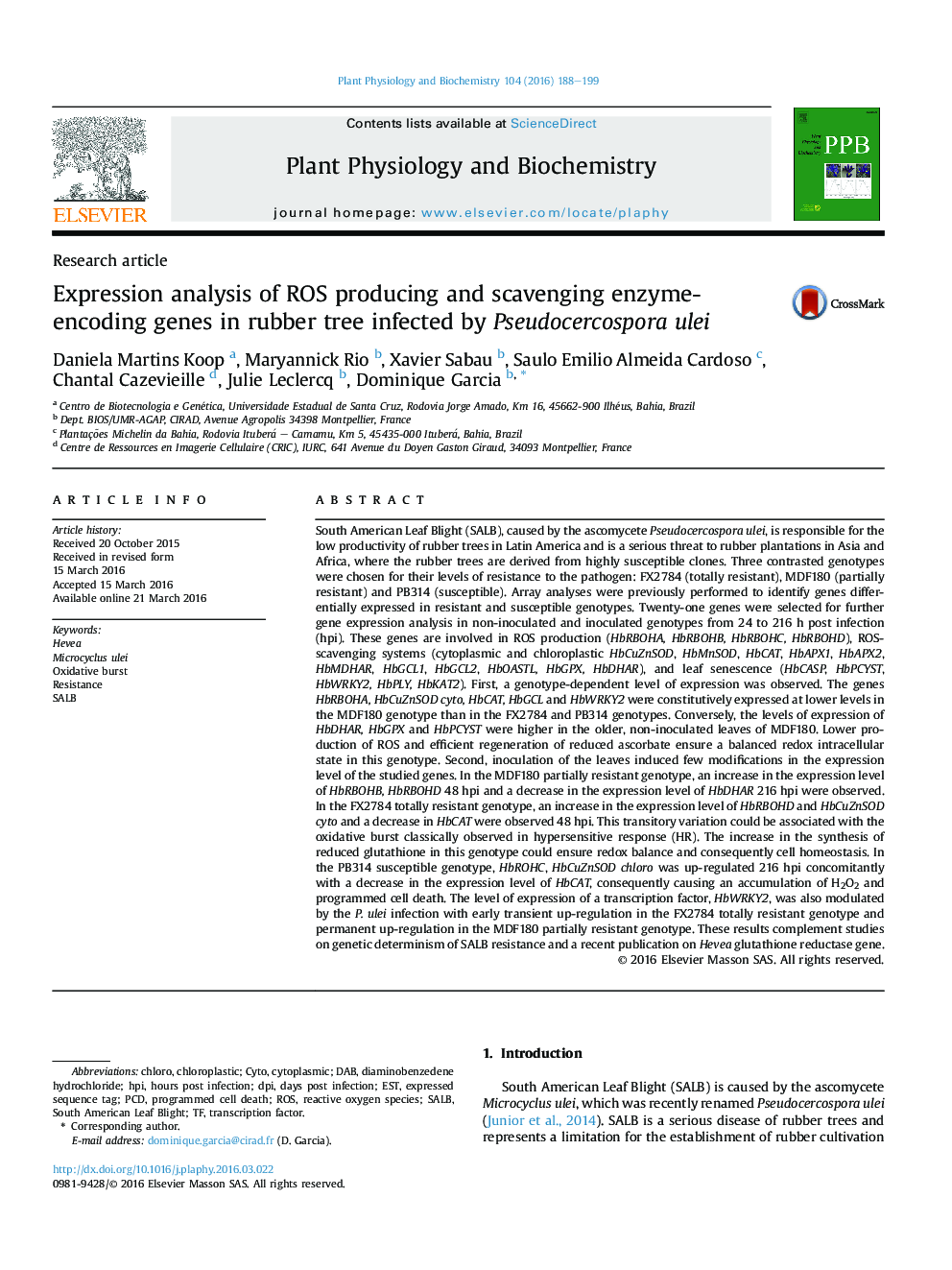| کد مقاله | کد نشریه | سال انتشار | مقاله انگلیسی | نسخه تمام متن |
|---|---|---|---|---|
| 2014764 | 1541917 | 2016 | 12 صفحه PDF | دانلود رایگان |

• Three Hevea genotypes with contrasting resistances to SALB presented different behaviours in ROS regulation.
• Basal expression levels of HbRBOHA (low), HbCAT (low) and HbDHAR (high) indicated a balanced cellular redox state in MDF180.
• Pseudocercospora ulei infection induced a permanent up-regulation of the WRKY2 expression level in MDF180.
• In FX2784, up-regulation of HbRBOHD expression level and down-regulation of HbCAT indicated an oxidative burst at 48 hpi.
• In FX2784, signalisation (HbWRKY2), enzymatic ROS (HbGPX) and non-enzymatic ROS (HbGCL) elimination were also regulated at 48 hpi.
• In PB314, HbRBOHC, HbCuZnSOD cyto and HbCAT expression levels strengthened histo- and cytological observations at 216 hpi.
South American Leaf Blight (SALB), caused by the ascomycete Pseudocercospora ulei, is responsible for the low productivity of rubber trees in Latin America and is a serious threat to rubber plantations in Asia and Africa, where the rubber trees are derived from highly susceptible clones. Three contrasted genotypes were chosen for their levels of resistance to the pathogen: FX2784 (totally resistant), MDF180 (partially resistant) and PB314 (susceptible). Array analyses were previously performed to identify genes differentially expressed in resistant and susceptible genotypes. Twenty-one genes were selected for further gene expression analysis in non-inoculated and inoculated genotypes from 24 to 216 h post infection (hpi). These genes are involved in ROS production (HbRBOHA, HbRBOHB, HbRBOHC, HbRBOHD), ROS-scavenging systems (cytoplasmic and chloroplastic HbCuZnSOD, HbMnSOD, HbCAT, HbAPX1, HbAPX2, HbMDHAR, HbGCL1, HbGCL2, HbOASTL, HbGPX, HbDHAR), and leaf senescence (HbCASP, HbPCYST, HbWRKY2, HbPLY, HbKAT2). First, a genotype-dependent level of expression was observed. The genes HbRBOHA, HbCuZnSOD cyto, HbCAT, HbGCL and HbWRKY2 were constitutively expressed at lower levels in the MDF180 genotype than in the FX2784 and PB314 genotypes. Conversely, the levels of expression of HbDHAR, HbGPX and HbPCYST were higher in the older, non-inoculated leaves of MDF180. Lower production of ROS and efficient regeneration of reduced ascorbate ensure a balanced redox intracellular state in this genotype. Second, inoculation of the leaves induced few modifications in the expression level of the studied genes. In the MDF180 partially resistant genotype, an increase in the expression level of HbRBOHB, HbRBOHD 48 hpi and a decrease in the expression level of HbDHAR 216 hpi were observed. In the FX2784 totally resistant genotype, an increase in the expression level of HbRBOHD and HbCuZnSOD cyto and a decrease in HbCAT were observed 48 hpi. This transitory variation could be associated with the oxidative burst classically observed in hypersensitive response (HR). The increase in the synthesis of reduced glutathione in this genotype could ensure redox balance and consequently cell homeostasis. In the PB314 susceptible genotype, HbROHC, HbCuZnSOD chloro was up-regulated 216 hpi concomitantly with a decrease in the expression level of HbCAT, consequently causing an accumulation of H2O2 and programmed cell death. The level of expression of a transcription factor, HbWRKY2, was also modulated by the P. ulei infection with early transient up-regulation in the FX2784 totally resistant genotype and permanent up-regulation in the MDF180 partially resistant genotype. These results complement studies on genetic determinism of SALB resistance and a recent publication on Hevea glutathione reductase gene.
Journal: Plant Physiology and Biochemistry - Volume 104, July 2016, Pages 188–199